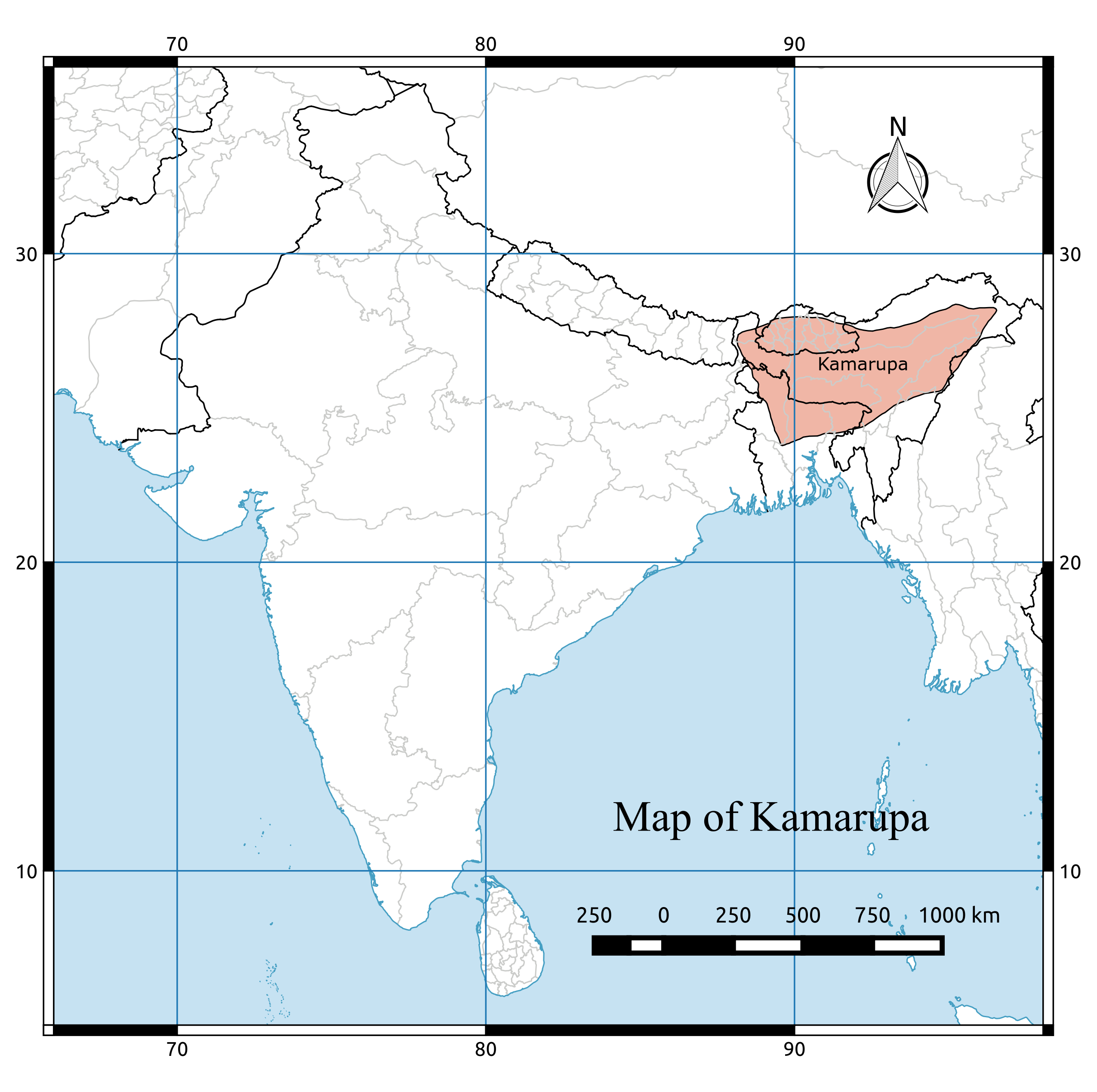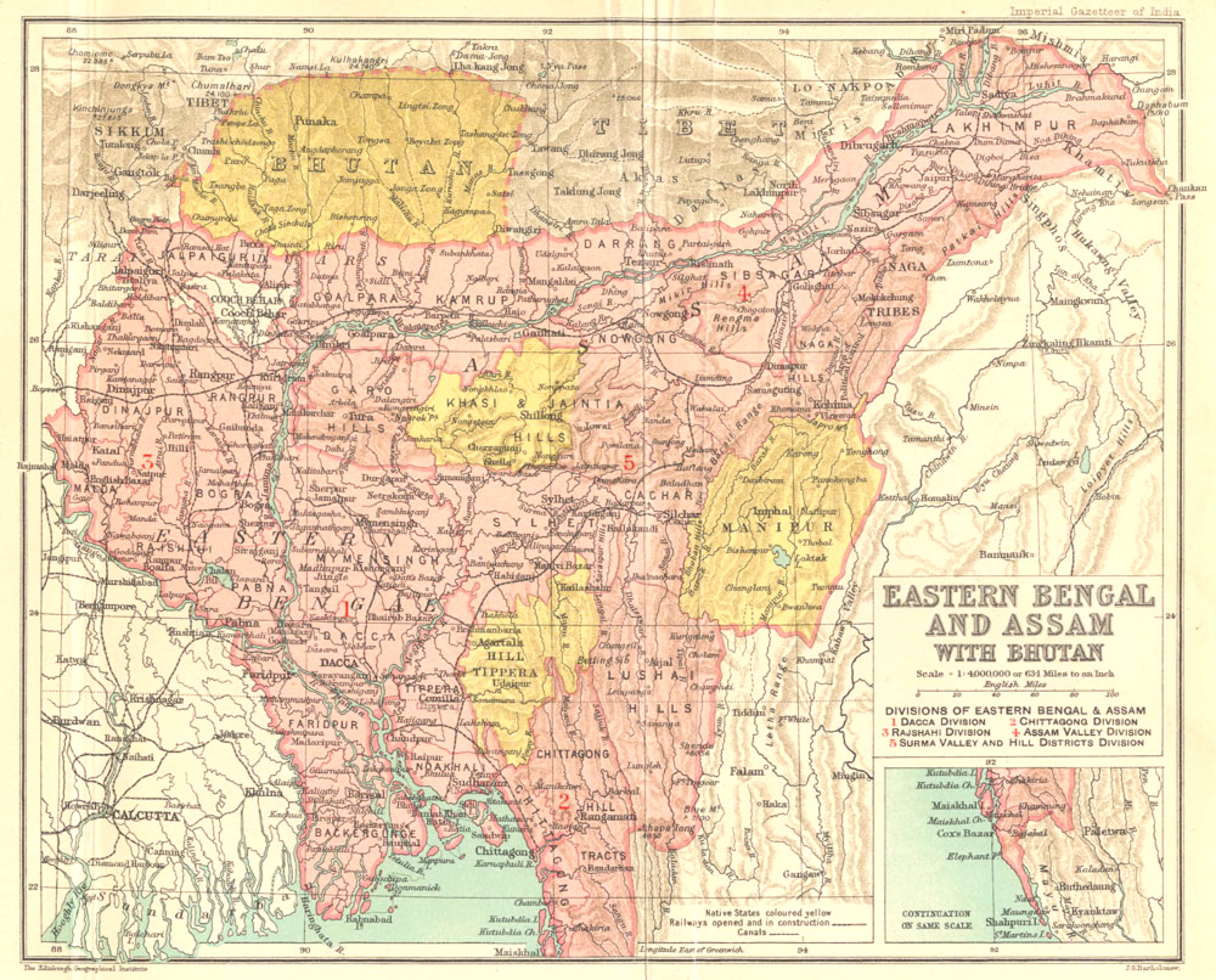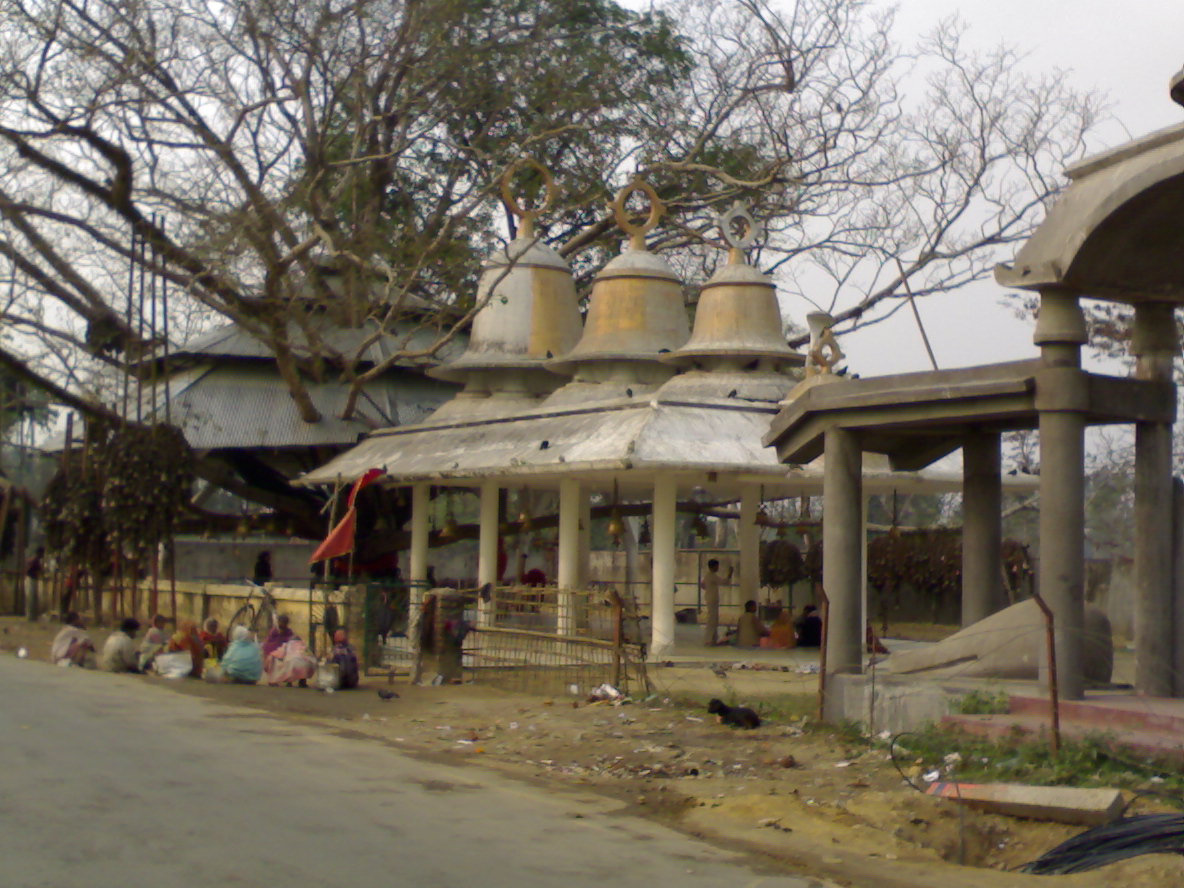|
Chutiya
The Chutia Kingdom (also Sadiya) was a late medieval state that developed around Sadiya in present Assam and adjoining areas in Arunachal Pradesh."(T)he Chutiyas seem to have assumed political power in Sadiya and contiguous areas falling within modern Arunachal Pradesh." It extended over almost the entire region of present districts of Lakhimpur, Dhemaji, Tinsukia, and some parts of Dibrugarh in Assam,"Their kingdom called Sadiya extended in the north over the entire region from the Sisi in the west to the Brahmaputra in the east. The hills and the river Buri Dihing formed its northern and southern boundaries respectively. Thus the Chutiya territory extended over almost the entire region of present districts of Lakhimpur, Dhemaji, Tinsukia, and some parts of Dibrugarh." as well as the plains and foothills of Arunachal Pradesh. The kingdom fell in 1523-1524 to the Ahom Kingdom after a series of conflicts and the capital area ruled by the Chutia rulers became the adminis ... [...More Info...] [...Related Items...] OR: [Wikipedia] [Google] [Baidu] |
Dimasa Kingdom
The Dimasa Kingdom (also Kachari kingdom) was a late medieval/early modern kingdom in Assam, Northeast India ruled by Dimasa kings. The Dimasa kingdom and others ( Kamata, Chutiya) that developed in the wake of the Kamarupa kingdom were examples of new states that emerged from indigenous communities in medieval Assam as a result of socio-political transformations in these communities. The British finally annexed the kingdom: the plains in 1832 and the hills in 1834. This kingdom gave its name to undivided Cachar district of colonial Assam. And after independence the undivided Cachar district was split into three districts in Assam: Dima Hasao district (formerly ''North Cachar Hills''), Cachar district, Hailakandi district. The Ahom Buranjis called this kingdom ''Timisa''. In the 18th century, a divine Hindu origin was constructed for the rulers of the Kachari kingdom and it was named Hidimba, and the kings as Hidimbesvar. The name Hiḍimbā continued to be used in the o ... [...More Info...] [...Related Items...] OR: [Wikipedia] [Google] [Baidu] |
Lakhimpur District
Lakhimpur district ( ) is an administrative district in the state of Assam in India. The district headquarter is located at North Lakhimpur. The district is bounded on the North by Siang and Papumpare districts of Arunachal Pradesh and on the East by Dhemaji District and Subansiri River. Majuli District stands on the Southern side and Biswanath District is on the West. Etymology The name ''Lakhimpur'' was derived from the name "Lakshmipur" which was given by the Chutiya king named Lakshminaryan who ruled during the 15th century. Later, it was changed by the Baro-Bhuyans to Lakhimpur, when they were made feudal lords of the region by the Ahoms after defeating the Chutiya kings and was kept in memory of the land (in present-day Darrang district), which they lost to the Koch kingdom. History Lakhimpur figures largely in the annals of Assam as the region where tribes from the east first reached the Brahmaputra. The most prominent of them was the Chutiya rulers who held th ... [...More Info...] [...Related Items...] OR: [Wikipedia] [Google] [Baidu] |
History Of Assam
File:Major kingdoms of Assam.png, upright=1.3, Major kingdoms of Assam rect 50 50 650 120 Kamarupa Kingdom rect 45 240 160 310 Kamata Kingdom rect 165 240 300 310 Bhuyan chieftains rect 305 240 415 310 Ahom Kingdom rect 425 240 540 310 Chutiya Kingdom rect 550 240 660 310 Kachari Kingdom rect 4 425 80 495 Koch Bihar rect 120 425 190 495 Koch Hajo rect 125 660 640 760 History of Assam The history of Assam is the history of a confluence of people from the east, west, south and the north; the confluence of the Austroasiatic, Tibeto-Burman (Sino-Tibetan), Tai and Indo-Aryan cultures. Although invaded over the centuries, it was never a vassal or a colony to an external power until the third Burmese invasion in 1821, and, subsequently, the British ingress into Assam in 1824 during the First Anglo-Burmese War. The Assamese history has been derived from multiple sources. The Ahom kingdom of medieval Assam maintained chronicles, called Buranjis, written in the Ahom ... [...More Info...] [...Related Items...] OR: [Wikipedia] [Google] [Baidu] |
Sadiya
Sadiya is a town in Tinsukia district, Assam. It was the capital of the Chutia Kingdom and after the downfall of the kingdom it became the seat of the ''Sadiya-khowa-Gohain'' of the Ahom kingdom. Extensive remains of buildings and fortifications built during the rule of the Chutias near Sadiya still point to the importance of the region in the past. Historically Sadiya referred to the Chutiya kingdom which included at times the districts of Lakhimpur, Dhemaji and Tinsukia. It is claimed to be the center of development of the eastern Assamese dialects, the inscription here are written in a Tai script. Its stands on a grassy plain, almost surrounded by forested Himalayan mountains, on the right bank of Lohit River which is locally (but erroneously) considered the main stream of the Brahmaputra River. The deepest point of the Brahmaputra River is located near this village. It is famous for a flower named ''satphul'' (the word means "blessing" or a "desert flower"), which is ... [...More Info...] [...Related Items...] OR: [Wikipedia] [Google] [Baidu] |
Assam
Assam (; ) is a state in northeastern India, south of the eastern Himalayas along the Brahmaputra and Barak River valleys. Assam covers an area of . The state is bordered by Bhutan and Arunachal Pradesh to the north; Nagaland and Manipur to the east; Meghalaya, Tripura, Mizoram and Bangladesh to the south; and West Bengal to the west via the Siliguri Corridor, a wide strip of land that connects the state to the rest of India. Assamese language, Assamese and Boro language (India), Boro are the official languages of Assam, while Bengali language, Bengali is an additional official language in the Barak Valley. Assam is known for Assam tea and Assam silk. The state was the first site for Oil well, oil drilling in Asia. Assam is home to the one-horned Indian rhinoceros, along with the wild water buffalo, pygmy hog, tiger and various species of Asiatic birds, and provides one of the last wild habitats for the Asian elephant. The Economy of Assam, Assamese economy is aided by w ... [...More Info...] [...Related Items...] OR: [Wikipedia] [Google] [Baidu] |
Deori Language
Deori (also Deuri) is a Tibeto-Burman language in the Sino-Tibetan language family spoken by the Deori people of Assam and Arunachal Pradesh. Among the four territorial groups only the Dibongiya have retained the language. The others—Patorgoyan, Tengaponiya, and Borgoyan—have shifted to Assamese. It is spoken in Lohit district of Arunachal Pradesh, and in Lakhimpur, Dhemaji, Tinsukia, and Jorhat districts of Assam. In the colonial times this language became associated with the Chutia people erroneously, and came to be known as the "Chutia language" in the Linguistic Survey of India. Modern scholarship do not associate the Deori language with the Chutia community. The Deori language is one of the most influential languages which has helped develop the Assamese language Assamese (), also Asamiya ( ), is an Indo-Aryan language spoken mainly in the north-east Indian state of Assam, where it is an official language, and it serves as a ''lingua franca'' of the wider r ... [...More Info...] [...Related Items...] OR: [Wikipedia] [Google] [Baidu] |
Tinsukia District
Tinsukia district () is one of the 34 administrative districts in the state of Assam, India. The district headquarters is located at Tinsukia city. The district occupies an area of 3790 km2. Towns *Digboi * Doomdooma *Jagun * Kakopathar * Lido Town *Makum *Margherita *Sadiya *Tinsukia History The area of the present district was an integral part of the Chutiya kingdom during the medieval period. After the defeat of the Chutias, the Ahoms placed ''Sadiya-khowa gohain'' to rule the region. Later, the Matak kingdom rose in its place after the Moamoria rebellion. The older name of Tinsukia city was ''Bengmara''. It was later made the capital of the Motok Kingdom when a member of the former Chutia royal family named Sarbananada Singha established his capital at Rangagarh situated in the bank of river Guijan. In 1791 AD, he transferred his capital to the city of Bengmara. Bengmara was built by King Sarbananda Singha with the help of his Minister, Gopinath Barbaruah (alias Godh ... [...More Info...] [...Related Items...] OR: [Wikipedia] [Google] [Baidu] |
Dhemaji District
Dhemaji district (Pron:deɪˈmɑ:ʤi or di:ˈmɑ:ʤi) is an administrative district in the state of Assam in India. The district headquarters are located at Dhemaji and commercial headquarters being located Silapathar. The district occupies an area of 3237 km² and has a population of 686,133 (as of 2011). Main religions are Hindus 548,780, Muslims 10,533, Christians 6,390. Etymology The district's name ''Dhemaji'' is derived from the Deori-Chutia word ''Dema-ji'' which means ''great water'' indicating it to be a flood-prone region. History The areas of the present district was part of the greater Chutiya kingdom along with Lakhimpur, Tinsukia, Jorhat, Dibrugarh and Sonitpur district from the 12th century to the 16th century until the Ahom-Chutiya conflict during the early period of the 16th century. The Ahoms created a new position ''Banlungia Gohain'' to control the area. Monuments built during the Chutia rule include Malinithan, Garakhia Than, Bordoloni Than and ... [...More Info...] [...Related Items...] OR: [Wikipedia] [Google] [Baidu] |
Kamarupa
Kamarupa (; also called Pragjyotisha or Pragjyotisha-Kamarupa), an early state during the Classical period on the Indian subcontinent, was (along with Davaka) the first historical kingdom of Assam. Though Kamarupa prevailed from 350 to 1140 CE, Davaka was absorbed by Kamarupa in the 5th century CE."As regards the eastern limits of the kingdom, Davaka was absorbed within Kamarupa under Kalyanavarman and the outlying regions were brought under subjugation by Mahendravarman." Ruled by three dynasties from their capitals in present-day Guwahati, North Guwahati and Tezpur, Kamarupa at its height covered the entire Brahmaputra Valley, North Bengal, Bhutan and northern part of Bangladesh, and at times portions of what is now West Bengal, Bihar and Sylhet. Though the historical kingdom disappeared by the 12th century to be replaced by smaller political entities, the notion of Kamarupa persisted and ancient and medieval chroniclers continued to call a part of this kingdom Kamru ... [...More Info...] [...Related Items...] OR: [Wikipedia] [Google] [Baidu] |
Medieval India
Medieval India refers to a long period of Post-classical history of the Indian subcontinent between the "ancient period" and "modern period". It is usually regarded as running approximately from the breakup of the Gupta Empire in the 6th century CE to the start of the Early modern period in 1526 with the start of the Mughal Empire, although some historians regard it as both starting and finishing later than these points. The medieval period is itself subdivided into the Early Medieval and Late Medieval eras. In the Early Medieval period, there were more than 40 different states on the Indian subcontinent, which hosted a variety of cultures, languages, writing systems, and religions. At the beginning of the time period, Buddhism was predominant throughout the area, with the short-lived Pala Empire on the Indo Gangetic Plain sponsoring the Buddhist faith's institutions. One such institution was the Buddhist Nalanda University in modern-day Bihar, India, a centre of scholar ... [...More Info...] [...Related Items...] OR: [Wikipedia] [Google] [Baidu] |
Buranji
Buranjis (Ahom language: ''ancient writings'') are a class of historical chronicles and manuscripts associated with the Ahom kingdom written initially in Ahom Language and later in Assamese language as well. The Buranjis are an example of historical literature which is rare in India; though they bear resemblance to Southeast Asian traditions of historical literature.The Buranjis are generally found in manuscript form (locally called ''puthi''), though many of these manuscripts have been compiled and published. They are some of the primary sources of historical information of Assam's medieval past, especially from the 13th century to the colonial times in 1828. There were two types of ''Buranjis'': the official Buranjis, which were compiled from the time of the first Ahom king Sukaphaa; and family Buranjis, which were compiled from the 16th century. The official Buranjis contained such information as description of important events as reported by reliable witnesses, corresponden ... [...More Info...] [...Related Items...] OR: [Wikipedia] [Google] [Baidu] |
Narakasura
Naraka, also known as Narakasura (), is an asura king in Hindu mythology. In Assamese tradition, he is regarded as the legendary progenitor of all three dynasties of Pragjyotisha-Kamarupa, and the founding ruler of the legendary Bhauma dynasty of Pragjyotisha. Though the myths about Naraka are first mentioned in the Mahabharata, later texts embellish them. According to later post-Vedic texts such as the Brahma Purana and Vishnu Purana, he was the son of Bhudevi, fathered either by the Varaha incarnation of Vishnu or Hiranyaksha. He is claimed as one who established Pragjyotisha. He was killed by Krishna and Satyabhama. His son Bhagadatta—of Mahabharata fame—succeeded him. The 10th/11th-century Kalika Purana embellishes the myths further and he is claimed to have come from Mithila and said to have established the kingdom of Pragjyotisha after overthrowing the last of the Kirata kings, Ghatakasura, of the Danava dynasty. It was foretold that he would be destroye ... [...More Info...] [...Related Items...] OR: [Wikipedia] [Google] [Baidu] |
.png)



.jpg)




